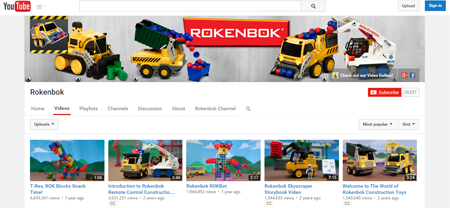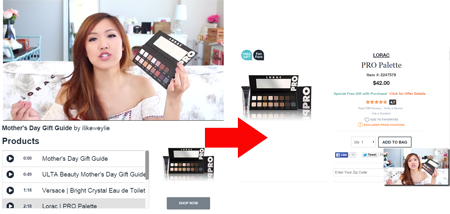
That’s a very compelling reason for marketers, if they haven’t yet, to start optimizing video.
According to Greg Jarboe, President and Co-Founder of SEO-PR, if your video thumbnail is featured on Google search results, it has a higher chance of getting clicked on, even if it isn’t ranked first.
Your video appearing on page 1 of Google search results or getting found on YouTube is no mean feat, however. Also, unless you’re in the entertainment industry, and you’re only after people watching your videos and subscribing to your channel so you can eventually be ad supported, you’d want videos that generate measurable results.
In an episode of Landing Page Optimization, Greg talks with SiteTuners CEO Tim Ash about getting your videos to appear in search engines , increasing clickthroughs, and creating videos that support conversions.
1. Provide a detailed description
In the last quarter of 2014, researchers at Google and Stanford University announced that they’ve created AI software that can identify image and video content and make auto- captions. The researchers reported that the algorithm’s descriptions were very close to the human-written ones.
This technology makes Googlebot’s ability to crawl video content a possibility in the future. Until then, however, marketers will need to optimize the text accompanying the video so it gets indexed and consequently, pops up in search engines.
Optimizing the title seems straightforward for most people on YouTube. The problem is when they settle with just a sentence or two for the description.
YouTube can take up to 800 words of text, up to 5000 of characters. Maximizing this – writing a long but relevant description – can help you on search. Greg reminds that although Google ignores the keywords meta tag, the same is not true for YouTube. The latter lives and dies with the meta tag, as it’s hard to figure out what the video is about without the written description to aid the YouTube algorithm.
2. Use an eye-catching thumbnail
Tim points out that some video thumbnails that YouTube generates are unattractive (e.g. a random frame in the video, with somebody’s mouth hanging half-open in mid-sentence, that becomes the cover shot). So, it’s best to craft a thumbnail that best visually represents the content.
Greg adds that if YouTube allows you to create a custom thumbnail – if your account is in good standing- but you don’t have the skill to do so, you can get the services of businesses like Vidpow.com. They’re familiar with YouTube’s editorial guidelines, so all you have to do is show them your video, and they can create a custom thumbnail for it for $5.00.
An eye-catching thumbnail increases the chance of the video getting clicked on if it appears in Google search results or even if it just pops up in YouTube search results. However, Greg warns against bait-and-switch. He notes that increasingly, this method is going to get caught and penalized.
3. Make longer videos
“Short is better” turns out to be a myth, at least for YouTube marketing videos.
Greg notes that videos that are generating measurable results are in the 3 to 10-minute range.
Similar to television where it’s not the 30-second spot, but the 2-minute infomercial that generates the response, online, it’s the longer videos that prompt response. This is because they give you time to tell enough of a story. So instead of it merely generating awareness, the video tells people about the product’s features and benefits and allows you to include testimonials, case studies, special offers, or whatever your call-to-action (CTA) is.
Some of the best-producing videos are how-to videos. And if you’re going to show somebody how to do something, most of the time, that takes longer than 3 minutes.
So there’s nothing wrong with longer videos, as long as they’re engaging.
4. Prioritize content over production quality
Unless you’re creating music videos, where industry standards for production quality are very high, you should put content over production quality.
A lot of videos with average production quality get phenomenal results because people don’t care whether you’re glossy or not – they’re interested to know what you’re selling, why it’s good, and why they should act on your offer. Also, people see beyond the production quality and assess your thought-leadership or authority in your subject matter.
Rokenbok, a toy company, makes 50% of their sales off of YouTube, and they shoot with nothing more than an iPad, in a lot of cases.
If you’re doing videos in-house, it’s possible to do it with a crew of 2 to 3 people. You can also do it by hiring freelancers. There are a lot of really good videographers all over the world, so you can find someone talented locally, and you won’t have to pay to fly them to the location.
For how-to videos, on the low-end, you can get video editing software like Camtasia. You can utilize a green screen and aim your camera phone at it, since a lot of phones shoot 1080p these days.
5. Create a comparison video if you’re the challenger
In the research phase, when customers have a short set of sellers or providers they’re considering to solve their problem, a comparison video will work to your advantage if you’re the challenger. If everyone knows Brand A and you’re Brand X, then you might have to compare yourself to the leader.
If you’re the leader, however, show people your strengths and pay no attention to the challengers.
6. Have a call-to-action
At the end of the video, tell people what you want them to do next.
In YouTube, you can create an Associated Website annotation so you can include a link to a landing page on your website. That means that at the end of the video, you can put text like, ‘If you want to buy the product online, click here.’ You still can’t do e-commerce on YouTube, but you can add the link at the end of the video to drive people to a specific landing page.
Greg notes that there are new interesting players, such as JW player and Vinja, which enable you to do a little more e-commerce on the backend. You can take your YouTube video, drop it into the player, and instead of merely being able to do the social things that YouTube provides, users can now go sideways and see a related video or a special offer on the product.
Ulta, a cosmetics retailer, uses the Vinja Video on their ULTAHAUL Videos page to sell products as a YouTube personality or vlogger talks about them. The video is segmented into chapters with links to the product detail page (PDP). This allows users to continue watching the video while they look at the PDP.
Tim notes that another tool, Viewbix, allows you to have little tabs that hang off the side of the video and lets you add custom CTAs, regardless of where the video’s hosted.
Getting your video found is, in itself, tough work. So, make sure that if users do find them, they’re compelled to click on them and to stick around to hear you out. Tell enough of a story to generate response and enable viewers to act while or after watching the videos.




